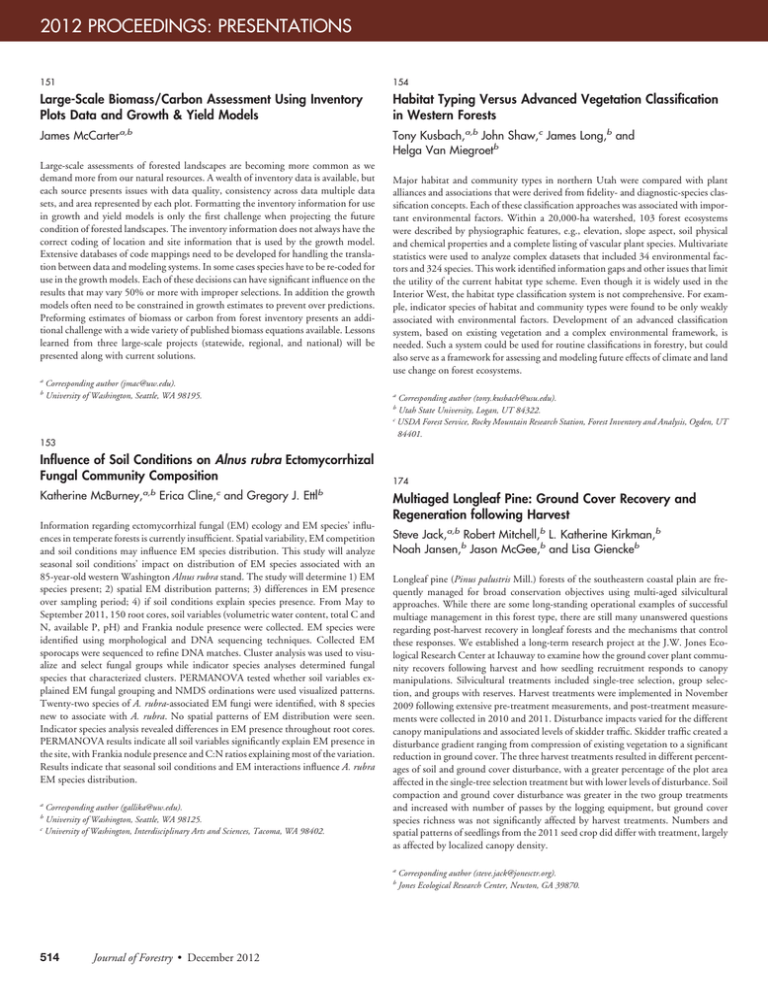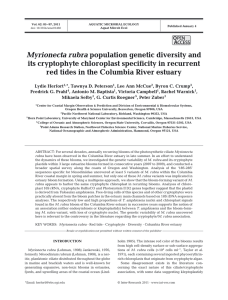Large-Scale Biomass/Carbon Assessment Using Inventory Habitat Typing Versus Advanced Vegetation Classification
advertisement

2012 PROCEEDINGS: PRESENTATIONS 151 154 Large-Scale Biomass/Carbon Assessment Using Inventory Plots Data and Growth & Yield Models Habitat Typing Versus Advanced Vegetation Classification in Western Forests James McCartera,b Tony Kusbach,a,b John Shaw,c James Long,b and Helga Van Miegroetb Large-scale assessments of forested landscapes are becoming more common as we demand more from our natural resources. A wealth of inventory data is available, but each source presents issues with data quality, consistency across data multiple data sets, and area represented by each plot. Formatting the inventory information for use in growth and yield models is only the first challenge when projecting the future condition of forested landscapes. The inventory information does not always have the correct coding of location and site information that is used by the growth model. Extensive databases of code mappings need to be developed for handling the translation between data and modeling systems. In some cases species have to be re-coded for use in the growth models. Each of these decisions can have significant influence on the results that may vary 50% or more with improper selections. In addition the growth models often need to be constrained in growth estimates to prevent over predictions. Preforming estimates of biomass or carbon from forest inventory presents an additional challenge with a wide variety of published biomass equations available. Lessons learned from three large-scale projects (statewide, regional, and national) will be presented along with current solutions. a b Corresponding author (jmac@uw.edu). University of Washington, Seattle, WA 98195. Major habitat and community types in northern Utah were compared with plant alliances and associations that were derived from fidelity- and diagnostic-species classification concepts. Each of these classification approaches was associated with important environmental factors. Within a 20,000-ha watershed, 103 forest ecosystems were described by physiographic features, e.g., elevation, slope aspect, soil physical and chemical properties and a complete listing of vascular plant species. Multivariate statistics were used to analyze complex datasets that included 34 environmental factors and 324 species. This work identified information gaps and other issues that limit the utility of the current habitat type scheme. Even though it is widely used in the Interior West, the habitat type classification system is not comprehensive. For example, indicator species of habitat and community types were found to be only weakly associated with environmental factors. Development of an advanced classification system, based on existing vegetation and a complex environmental framework, is needed. Such a system could be used for routine classifications in forestry, but could also serve as a framework for assessing and modeling future effects of climate and land use change on forest ecosystems. a Corresponding author (tony.kusbach@usu.edu). Utah State University, Logan, UT 84322. c USDA Forest Service, Rocky Mountain Research Station, Forest Inventory and Analysis, Ogden, UT 84401. b 153 Influence of Soil Conditions on Alnus rubra Ectomycorrhizal Fungal Community Composition Katherine McBurney,a,b Erica Cline,c and Gregory J. Ettlb Information regarding ectomycorrhizal fungal (EM) ecology and EM species’ influences in temperate forests is currently insufficient. Spatial variability, EM competition and soil conditions may influence EM species distribution. This study will analyze seasonal soil conditions’ impact on distribution of EM species associated with an 85-year-old western Washington Alnus rubra stand. The study will determine 1) EM species present; 2) spatial EM distribution patterns; 3) differences in EM presence over sampling period; 4) if soil conditions explain species presence. From May to September 2011, 150 root cores, soil variables (volumetric water content, total C and N, available P, pH) and Frankia nodule presence were collected. EM species were identified using morphological and DNA sequencing techniques. Collected EM sporocaps were sequenced to refine DNA matches. Cluster analysis was used to visualize and select fungal groups while indicator species analyses determined fungal species that characterized clusters. PERMANOVA tested whether soil variables explained EM fungal grouping and NMDS ordinations were used visualized patterns. Twenty-two species of A. rubra-associated EM fungi were identified, with 8 species new to associate with A. rubra. No spatial patterns of EM distribution were seen. Indicator species analysis revealed differences in EM presence throughout root cores. PERMANOVA results indicate all soil variables significantly explain EM presence in the site, with Frankia nodule presence and C:N ratios explaining most of the variation. Results indicate that seasonal soil conditions and EM interactions influence A. rubra EM species distribution. a Corresponding author (gallika@uw.edu). University of Washington, Seattle, WA 98125. c University of Washington, Interdisciplinary Arts and Sciences, Tacoma, WA 98402. b 174 Multiaged Longleaf Pine: Ground Cover Recovery and Regeneration following Harvest Steve Jack,a,b Robert Mitchell,b L. Katherine Kirkman,b Noah Jansen,b Jason McGee,b and Lisa Gienckeb Longleaf pine (Pinus palustris Mill.) forests of the southeastern coastal plain are frequently managed for broad conservation objectives using multi-aged silvicultural approaches. While there are some long-standing operational examples of successful multiage management in this forest type, there are still many unanswered questions regarding post-harvest recovery in longleaf forests and the mechanisms that control these responses. We established a long-term research project at the J.W. Jones Ecological Research Center at Ichauway to examine how the ground cover plant community recovers following harvest and how seedling recruitment responds to canopy manipulations. Silvicultural treatments included single-tree selection, group selection, and groups with reserves. Harvest treatments were implemented in November 2009 following extensive pre-treatment measurements, and post-treatment measurements were collected in 2010 and 2011. Disturbance impacts varied for the different canopy manipulations and associated levels of skidder traffic. Skidder traffic created a disturbance gradient ranging from compression of existing vegetation to a significant reduction in ground cover. The three harvest treatments resulted in different percentages of soil and ground cover disturbance, with a greater percentage of the plot area affected in the single-tree selection treatment but with lower levels of disturbance. Soil compaction and ground cover disturbance was greater in the two group treatments and increased with number of passes by the logging equipment, but ground cover species richness was not significantly affected by harvest treatments. Numbers and spatial patterns of seedlings from the 2011 seed crop did differ with treatment, largely as affected by localized canopy density. a b 514 Journal of Forestry • December 2012 Corresponding author (steve.jack@jonesctr.org). Jones Ecological Research Center, Newton, GA 39870.





